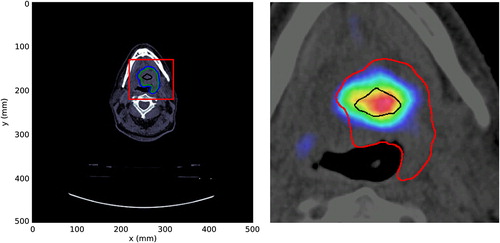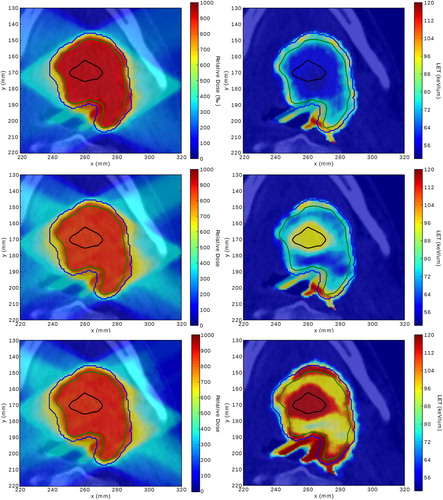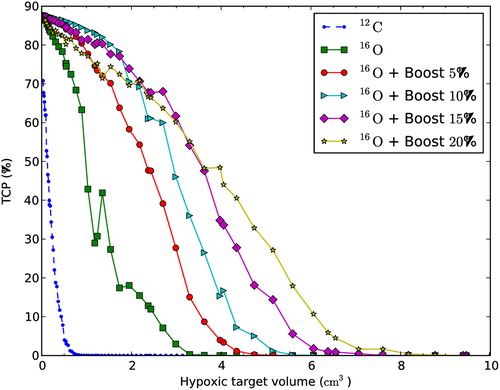Figures & data
Figure 1. Patient CT scan used for this study. All subsequent images presented in the results section show the section marked by the (red) box in the left figure. Here, the PTV and GTV are outlined with blue and green lines, respectively. The black structure in the center marks the HTV. Right figure shows details of the FAZA scan and the delineated HTV (black line). The larger structure (red) again marks the GTV. GTV, gross target volume; HTV, hypoxic target volume; PTV, planning target volume.

Figure 2. The O parameter from the hypoxia-extended RCR model [Citation18] as a function of LET for the V79 cell line used in this study. Õ is comparable with the OER at 10% survival. LET, linear energy transfer; OER, oxygen enhancement ratio; RCR, repairable-conditionally repairable.
![Figure 2. The O parameter from the hypoxia-extended RCR model [Citation18] as a function of LET for the V79 cell line used in this study. Õ is comparable with the OER at 10% survival. LET, linear energy transfer; OER, oxygen enhancement ratio; RCR, repairable-conditionally repairable.](/cms/asset/a508edc4-32e6-4c1f-821b-b1cd91296e06/ionc_a_832835_f0002_b.jpg)
Figure 3. Dose and dose-averaged LET profiles shown in left and right column, respectively. First row is a carbon-12 ion plan using four conventional fields with homogeneous dose. The highest LET is then found at the rim of the SOBPs as seen in the upper right figure. LET-painting, as shown in the middle row, allows for redistributing LET to cover the assumed hypoxic structure, depicted as the black entity, with increased LET. The energy fluence budget for the amount of particles used is the same for both plans in the upper two rows. The last row shows LET-painting again, but now with oxygen-16 ions, resulting in a pronounced increase of LET in the HTV. HTV, hypoxic target volume; LET, linear energy transfer; SOBP, spread out Bragg peak.

Figure 4. TCP calculated for the patient case, as a function of varying spherical HTV using carbon-12 ions, oxygen-16 ions and oxygen-16 ions with an additional dose boost to the HTV. The energy fluence is normalised for all plans to result in 95% TCP for their corresponding homogeneous normoxic cases. HTV, hypoxic target volume; TCP, tumour control probability.


